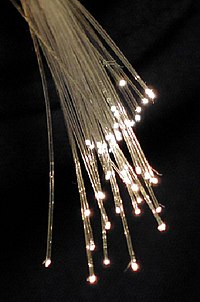
Photo from wikipedia
Abstract. A high-performance Brillouin optical time-domain analysis (BOTDA) is achieved using the Brillouin gain bandwidth reduction technique combined with high injected probe power. In the probe branch, dual-tone probe wave… Click to show full abstract
Abstract. A high-performance Brillouin optical time-domain analysis (BOTDA) is achieved using the Brillouin gain bandwidth reduction technique combined with high injected probe power. In the probe branch, dual-tone probe wave with fixed frequency separation is used for enhancing the probe power to +5 dBm. In the pump branch, a differential π-phase-shift long-pulse width pair is used to narrow the Brillouin gain spectrum. On the basis of high probe power and 2.5-m spatial resolution, the Brillouin gain spectrum can be narrowed to a level of 17 MHz, whereas the Brillouin gain spectrum of conventional single-pulse BOTDA sensor is 51 MHz. As a result, 50-km sensing range with 2.5-m spatial resolution and 1.1-MHz Brillouin frequency shift (BFS) accuracy has been achieved. Meanwhile, the narrowed Brillouin gain spectrum can give rise to sharp rising/falling edge in the BFS profile when the hot spots are introduced, which increases the detection robustness of the small temperature/strain change in the BOTDA system.
Journal Title: Optical Engineering
Year Published: 2018
Link to full text (if available)
Share on Social Media: Sign Up to like & get
recommendations!